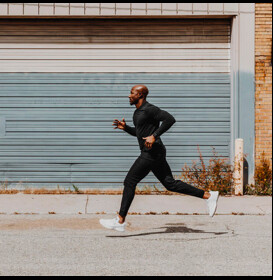Running News Daily
Running News Daily is edited by Bob Anderson. Send your news items to bob@mybestruns.com Advertising opportunities available. Train the Kenyan Way at KATA Kenya and Portugal owned and operated by Bob Anderson. Be sure to catch our movie A Long Run the movie KATA Running Camps and KATA Potato Farms - 31 now open in Kenya! https://kata.ke/
Index to Daily Posts · Sign Up For Updates · Run The World Feed
Who Has Stronger Legs – Runners or Cyclists? We Asked Experts to Find Out
Both endurance activities are great for cardiovascular health, but which is better when it comes to building lower limb strength?
Ever found yourself in a debate with your friends about which sport is better: running vs cycling? Perhaps you've squabbled over which sport makes you fitter, or even, who has stronger legs – runners or cyclists?

Well, next time you find yourself in a quarrel over that latter point, you might want to reference this very article.
To find out how each sport works our leg muscles differently, leading to differing strengths and physiques between runners and cyclists, we asked Dr Robin Chatterjee, consultant in musculoskeletal, sport and exercise medicine at Chelsea Outpatient Centre, part of HCA Healthcare UK, for some answers.
We also caught up with Jack Hutchins, pro triathlete and coach at Scientific Triathlon, to find out how incorporating cycling into your training week may help to improve running performance and reduce the risk of injury.
Which leg muscles do running and cycling use?
Broadly speaking, running and cycling are lower-limb forms of exercise and use the four main leg muscle groups: quadriceps, calves, glutes and hamstrings. But the action of each works them in different ways.
When pedaling, cyclists use the quads and the glutes to produce power – the quads just before the top of the stroke through to the bottom, while the glutes contribute to generating power while also stabilizing the hip. The hamstrings take care of six o’clock to nine o’clock of the pedal stroke and keep the knee stable when the leg is fully extended, while the calves help with ankle stability.
'The most important muscles [for cyclists] are the quadriceps – the muscles at the front of your thighs,' says Chatterjee. 'Cyclists often have these massive upper thighs – the reason is the constant pedalling action that leads to the over-development of the quads compared to the hamstrings or the glutes.'
It’s why cyclists’ legs
Moreover, strength imbalances are commonly the cause of injuries, so for example quad dominant runners are more susceptible to patellofemoral pain syndrome (more commonly known as runner’s knee) due to increased stress on the knees.
What other leg muscles are involved in running and cycling?
Aside from the key leg muscle groups, both forms of exercise require many more intricate muscles and tendons to keep you moving forward. The main supporting cast that running uses are:
Tensor fasciae lata (TFL), a hip flexor muscle that connects your pelvis to your IT band (which runs down the outside of your leg) and is recruited whenever you raise your leg up or out. It keeps your knees aligned as you drive forward and stabilizes the hips and pelvis as you lift each leg.
Tibialis posterior, a muscle that runs from the back of your shin to your foot via your inner ankle bone and provides your foot with stability and drive.
The flexor digitorum brevis, a muscle on the sole of your foot that provides flexion of your four smaller outer toes, aiding balance, weight distribution and forward momentum.
Cycling, meanwhile, recruits muscles including:
Adductor magnus, the largest groin muscle that extends
It's worth mentioning that the two forms of exercise also develop different fibers within our muscles at different ratios.
'We all have fast-twitch and slow-twitch [muscle] fibers and the ratio alters based on your activity,' explains Chatterjee. Every skeletal muscle (those used to move your bones) contains both fast and slow-twitch muscle fibers; the former is used for rapid, explosive movements like sprinting or jumping, while the latter is endurance-focused.
'Cyclists have [more] fast-twitch fibers – that type of muscle that generates power, which you need for sprints, climbs or long distance cycling. Whereas runners have [more] slow-twitch fibers, which are more fatigue resistant and better for endurance running.'
Is cycling a good form of cross training for runners?
Pro triathlete and coach Jack Hutchins says that integrating cycling into a runner's training can have myriad benefits.
The performance benefit, says Hutchins, is the result of an increased training load – in terms of both volume (duration) and intensity (how hard). If you’re just relying on running to do this, it can be difficult, particularly if your legs aren’t conditioned to ramp up the training load or you’re injury-prone. While beneficial for improving fitness and
'These long-duration workouts on the bike create significant metabolic stress and elicit some really good physiological benefits because you accumulate fatigue metabolites. The fitness transfers are not just cardiovascular – cycling uses similar muscle groups but recruits muscle fibers in a different way. You could do it [create the same training effect] by doing loads of double run days, but by having those one or two three to four hour sessions a week in your schedule, you get that different and additional stimulus you can't really get running.'
Hutchinson points out that long rides can even be fun! 'On a bike, you can get out and explore all day, which is good fun and stop for lunch. If athletes can incorporate a training session into a nice day out, they will probably do more training.'
If you don't own a bike, though, or you are a nervous cyclist, you can elicit the same training benefit by using an indoor bike or turbo trainer.
The way in which you fit sessions into your run training will depend on what your running goals are for the year but Hutchins suggests using cycling as part of building your base fitness before embarking on a training plan.
'Rather than doing loads of run volume all-year round, you can be a little bit more precise and use more cross training in the winter, base season or build phase and then save that increase in run volume for the competition or specific [phase] as you're leading into your big 'A' race.'
Chatterjee does, however, caution that while combing the two may reduce the risk of injury for some, be mindful that it's not a magic bullet as, in doing so, 'you are taking on the risk of injury from both [sports]', citing buttock pain and lower back pain as niggles sometimes seen in cyclists.
by Runners World
Login to leave a comment




